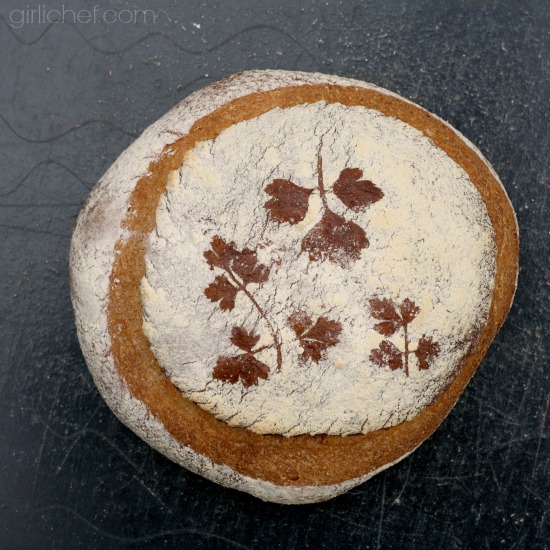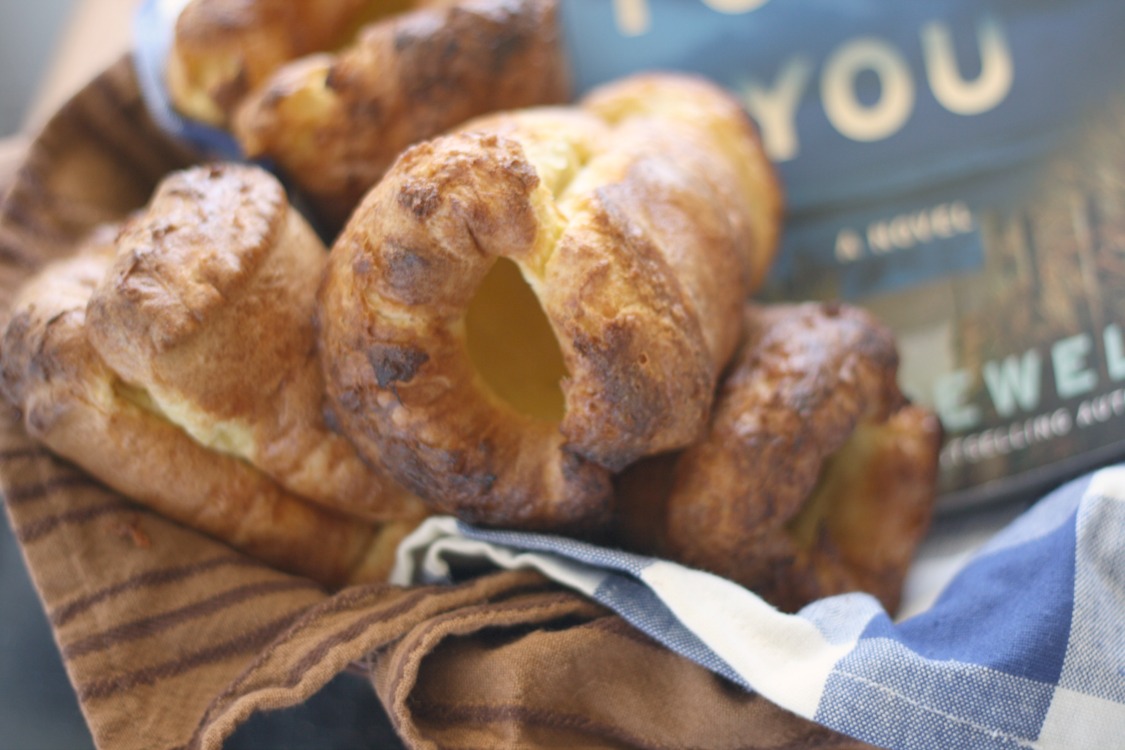Our host Babe for the month is Ilva from Lucullian Delights, and her assignment for us was one rooted deep in history—354 years to be exact. This French bread was originally published in 1660, in one of those glorious old cookery books that now take a bit of study to interpret, The Accomplisht Cook; or the Art & Mystery of Cookery by Robert May. And yes, accomplisht is the proper old-English spelling. The recipe saw a bit of a revival when it appeared in the pages of the 1977 cookbook English Bread and Yeast Cookery, by British cookery writer Elizabeth David (you may remember her being on the list of 50 Women Game-Changers in Food that I cooked through a couple of years ago).
Well, the BBBabes are making old new once again. Ilva invited us to bake this simple egg white-infused bread (not sure exactly what role the egg whites played, but I went with it)—the actual challenge lying not so much in the recipe itself, but in the decoration of the bread. We were to get creative with the presentation.
I met her challenge by finally trying something that I've ruminated on for a number of years. It churned in the back of my mind, waiting for its reveal. What better time than now to bring it to light.
I don't remember the exact loaf, or the exact time, but I know I've laid eyes on a crust with an herb "impression" in the past. I mean, surely that's what originally planted the seed. I didn't find any instruction on it, but I also didn't look very hard. I had an idea of how to accomplish what I pictured. I used the yolks leftover from those egg whites, beaten with a dribble of water, as a sort of glue to hold down some pretty parsley leaves. Then I dusted the loaf with flour and let it rise.
After the dough expanded, I could see that impression wouldn't be very defined, so I coated it with another layer of flour before slashing and baking it. I didn't want an explosion, so I chose to slash it around the outside, figuring it would lift like a cap, of sorts with the heat (fortunately it did). I went back and forth about whether I should remove the leaves before or after baking. I opted for before—mainly because I couldn't stop picturing burnt herbs that wouldn't peel off nicely. I think I made the right decision. The only thing I will do differently next time is to gently brush off some of the excess flour after the second dusting. I believe this will help to define the outline of the herbs and make them pop a bit more.
What do you think? How would you choose to decorate this bread - seeds, nuts, designs made with set-aside dough? Visit the other BBBabes to see how they chose to decorate their loaves, and then head into the kitchen and bake your own, because we'd love to have you join us as a Bread Baking Buddy this month (for more details on how to join us, scroll down to the bottom of this post)!
Robert May's French Bread
This simple French bread is chewy with a thick crust is adapted from a 354-year old recipe from Robert May.


by
Prep Time: 150 minutes (mostly unattended)
Cook Time: 45 minutes
Keywords: bake bread dairy-free vegetarian nut-free soy-free sugar-free flour
Ingredients (1 loaf)
- 10 fluid ounces (1-1/4 cups) lukewarm water (110° F)
- 7 grams (2-1/4 teaspoons) active dry yeast
- 2 large egg whites, beaten until frothy (reserve the yolks)
- 250 grams (9 ounces) unbleached bread flour
- 250 grams (9 ounces) whole wheat flour
- 10 grams salt
- reserved egg yolks + a dribble of water
- a few fresh parsley leaves
- flour
Instructions
Put the lukewarm water into a large bowl; sprinkle the yeast over the top of the water, and allow to sit and bloom (it should look creamy).
Add the frothy egg whites to the bowl, as well as both flours and the salt. Mix with a wooden spoon to combine. As you're mixing, pour in a little of the remaining liquid at a time until dough comes together (you may have a bit left over). Turn dough out of bowl and knead for a few minutes, until it is starting to look smooth, and is just slightly tacky on the surface.
Form dough into a ball and place into a lightly oiled bowl. Cover the bowl and allow the dough to rise until spongy and light, 45-60 minutes.
Turn dough out onto a lightly floured surface and knead for a minute or two; at this point the dough should be soft and pillowy. Flatten it into a thick disc, then fold each "side" to the center. Flip the dough over and "tuck and turn" until you have a nice ball of dough. If your work surface doesn't have any flour left on it, give it a light dusting, then set the ball of dough back on it.
Use the reserved egg yolks, beaten with a little bit of water to lightly paint the underside of a couple of herb leaves or sprigs, then paste them onto the dough.
They should dry fairly quickly, at that point, dust the dough with a good coat of flour. Cover loosely with plastic wrap and allow to rise until almost doubled in size, 45-60 minutes.
Set a baking stone on the center rack, then preheat oven to 450° F during last 20 minutes of rise time. Set a baking stone on the center rack to preheat also, if you are using one.
Remove the plastic and scatter another good coat of flour over the dough. Now, I know this seems counter-intuitive, but very gently dust off most of the excess flour, taking care not to disturb the herbs (it will make your herb leaf "design" pop!). Use a very sharp knife, razor blade, or lame to score a circle around the dough, about 1/2-inch from the edge. As carefully as you can, slide a fingernail underneath your herbs and lift them up, leaving a decorative "open" design.
Open the preheated oven, slide the loaf onto the stone (or slide the baking sheet in), throw 3 ice cubes into the bottom of the oven (for steam) and and bake for 30 minutes. Overturn a large oven-proof bowl or casserole (or foil if you don't have one that fits) over the loaf after 15 minutes to keep the crust from getting too hard.
The original recipe called for a mixture of water and milk, but I chose to go with all water. If you like, use both (about 3/4 of it being water, and 1/4 of it being milk).
The Bread Baking Babes (current dozen) are:
The Bread Baking Buddies are: YOU!
So which Babe is the hosting kitchen this month? That would be Ilva at Lucullian Delights, if you'd like to join in, simply make Robert May's French Bread (and your own decorative dough) - and then send Ilva your link (info in her announcement post). Submissions are due by September 28th. Once you've posted, you'll receive a Buddy badge for baking along. I hope you'll join us this month!
- Bake My Day - Karen
- blog from OUR kitchen - Elizabeth
- Bread Experience - Cathy
- Feeding my Enthusiasms - Pat/Elle
- All Roads Lead to the Kitchen - Heather
- Life's a Feast - Jamie
- Living in the Kitchen with Puppies - Natashya
- Lucullian Delights - Ilva
- My Diverse Kitchen - Aparna
- My Kitchen In Half Cups - Tanna
- Notitie Van Lien - Lien
- Thyme for Cooking - Katie (Bitchin’ Bread Baking Babe Bibliothécaire)
The Bread Baking Buddies are: YOU!
So which Babe is the hosting kitchen this month? That would be Ilva at Lucullian Delights, if you'd like to join in, simply make Robert May's French Bread (and your own decorative dough) - and then send Ilva your link (info in her announcement post). Submissions are due by September 28th. Once you've posted, you'll receive a Buddy badge for baking along. I hope you'll join us this month!
I am also sending this bread to Susan's Yeastspotting!










